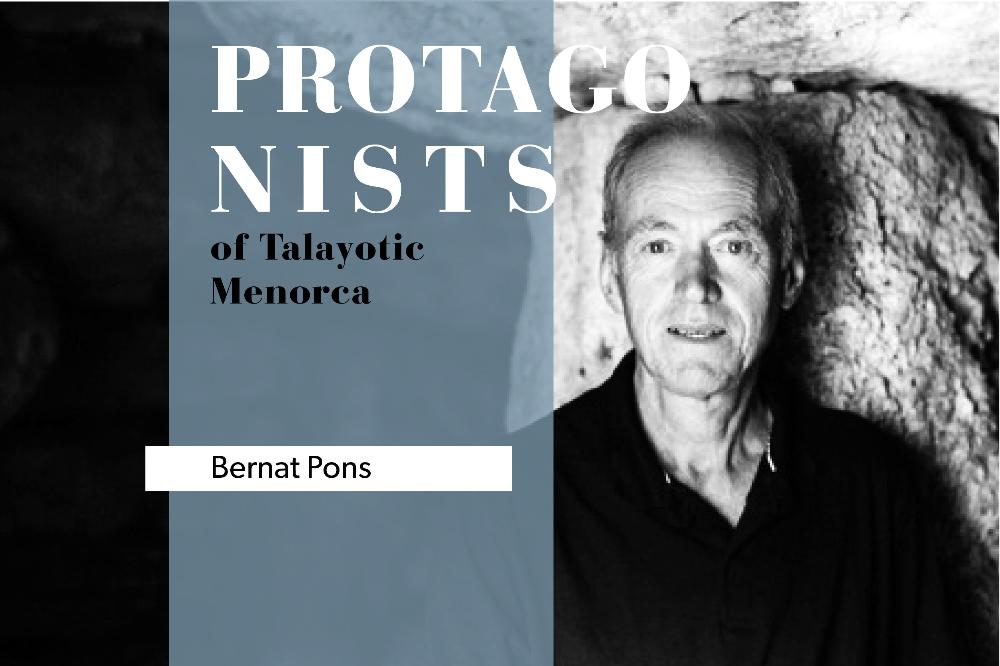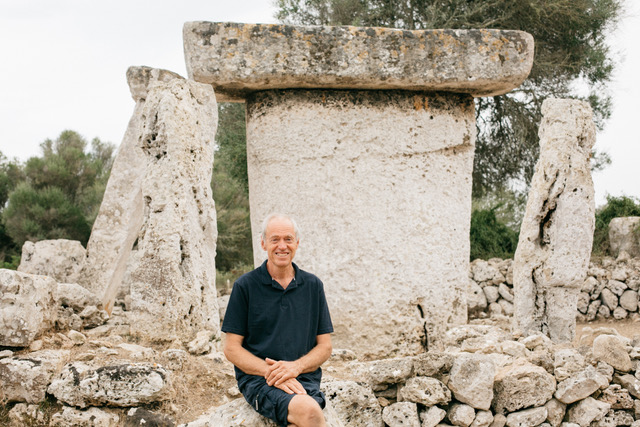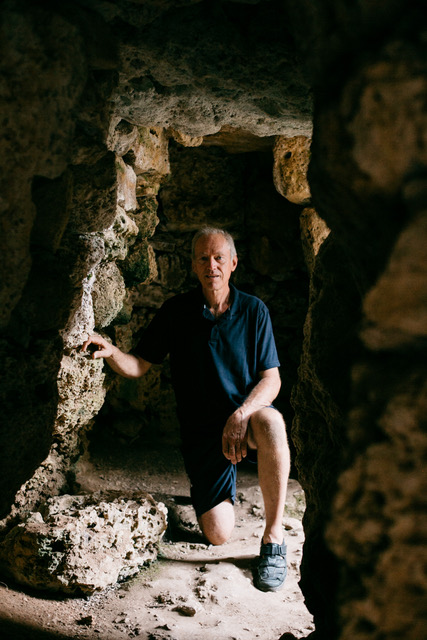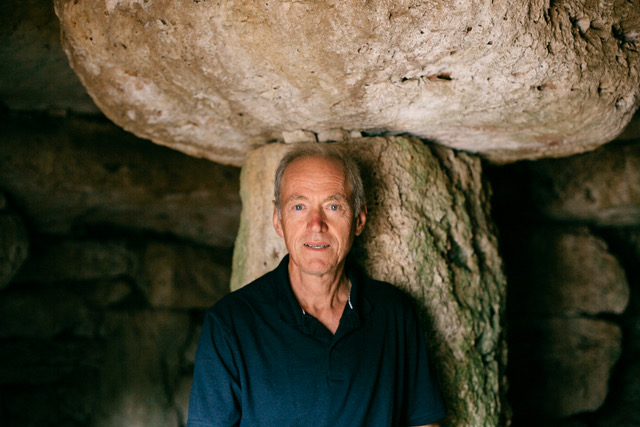 Bernat Pons is the owner of Talatí de Dalt, one of the most emblematic Talayotic sites in Menorca. Its peculiar taula, with a supporting lateral pilaster, has become one of the iconic images of Talayotic Menorca. Since he was little, he learned how to build dry stone walls and do farm work, spending summers helping on the family farm, very close to Talatí: "I have many childhood memories playing around this taula, for me it is the most special place." Working since he was 14 years old, he now runs the Talatí de Dalt farm with his family. This exploitation of ecological and livestock agriculture has been complemented for 17 years with tourist visits to the archaeological zone where you can find a Talayotic town, a necropolis of artificial caves, sections of a wall, a taula sanctuary and Talayotic houses.
Bernat Pons is the owner of Talatí de Dalt, one of the most emblematic Talayotic sites in Menorca. Its peculiar taula, with a supporting lateral pilaster, has become one of the iconic images of Talayotic Menorca. Since he was little, he learned how to build dry stone walls and do farm work, spending summers helping on the family farm, very close to Talatí: "I have many childhood memories playing around this taula, for me it is the most special place." Working since he was 14 years old, he now runs the Talatí de Dalt farm with his family. This exploitation of ecological and livestock agriculture has been complemented for 17 years with tourist visits to the archaeological zone where you can find a Talayotic town, a necropolis of artificial caves, sections of a wall, a taula sanctuary and Talayotic houses.
How did the history of your family with Talatí begin?
Well, more than 30 years ago, when my mother still owned the land ahead and sold it. Later, in 1989, the whole family decided to buy Talatí. We saw that it had enormous potential, both as an agricultural operation, because it was a very large farm, and because of the archaeological site. At that time, it was considered that having remains like these inside a farm was a headache since there were always people who wanted to come to visit them. For our family, the truth is that buying Talatí has been the best thing that has happened to us in generations.
 And where did the idea of exploiting the site for tourism come from?
And where did the idea of exploiting the site for tourism come from?
In the beginning, we had dairy cows and it was not profitable. 25 years ago we decided to run the farm ourselves and we registered the second agrotourism license in all Menorca, which we later transformed into a rural house to have an extra income apart from the agricultural activity. The agricultural exploitation is focused on indigenous breeds of cow and sheep from Menorca and organic farming. I think we should have been among the first on the island to focus on organic farming.
After having the rural house, we contacted an English tour operator and the first tourists of this nationality began to arrive, who were already looking for rural tourism. In 1997 the Amics del Museu de Menorca requested permission to excavate the area of the talayotic houses with an archaeologist named De Nicolás. He was the one who proposed the idea of exploiting the site for tourism and we started doing it in 2004. We were partners until he retired. It’s been 10 years since we exploit it by ourselves and now our children take care of the site. When farming seems to have no viability, this farm has a guaranteed future, creates jobs and has an economic outlet. The site is a complement to the rest of the farm's activities.
Being a private property, you were among the first to exploit a site in Menorca for tourism. What possibilities did you see, beyond the economics?
That’s right, about 17 years ago as we said before. We were the first ones alongside the Fundació Illes Balears that bought Torralba d'en Salort. At that time, having a prehistoric site was not valued, it seemed like it was more of a problem. It is clear that to take good care of it you need an entry of money, that is why we charge entry during high season. At the end of October, when the turistic season ends, entrance is free for Menorcans to visit.
We can’t have a wonder like this, unique in the world, and not take care of it and let it rot. Today, luckily, people have acquired culture and understand that this is part of the legacy of the people of Menorca that must be preserved for future generations. We are here for a season and those who will come after us must find it the same or in better shape than how we have found it. It’s our responsibility to do so and it’s the main purpose of our work.
 This responsibility you are talking about, how much maintenance work does it involve?
This responsibility you are talking about, how much maintenance work does it involve?
Every winter we clean the plot and we prune the wild olive trees, maintenance is necessary otherwise it would be a disaster. The wild olive trees break the stones. Two months before the start of the tourist season, we let the sheep graze and eat all the grass, they’re a non-harmful animal, and we then just finish trimming ourselves.
When you bought Talatí, what shape was the site in?
Well, this was one more plot on the farm, everything was full of pebbles and wild olive trees. Cows, pigs and sheep were grazing here and the field was tilled. The archaeological remains were not important at the time. Notice that even when they built the Maó Military Base, they took a pile of stones from here that were surely from the Talayotic period.
My mother was born next door to hear, in Algendaró, and she told me that there had always been livestock here. The Talayotic houses were full of sheep manure because they went there to sleep. A man made a donation to Amics del Museu de Menorca so that they would come to excavate them. They did so between 1997 and 2001. Everything that was found inside was taken to the museum and is on display there. Since the times of the Arab domination, this site has not been reoccupied, therefore everything was as they had left it. Before opening the site to the public, we had to clean a lot, collect the small pebbles, as well as prepare the route and the signage.
And for you, what makes the Talatí site special?
The most important thing is that in a small piece of land you have everything. In Approximately 1 hectare you will find talayotic houses, dolmens, a talayot, a taula enclosure ... in the middle of a unique environment of well-preserved nature. What we offer is the experience of visiting a well- preserved part of rural Menorca.
What challenges have you faced during these 17 years?
At first, when we made the proposal to open the site to tourism there was reluctance, but then they realized that it had a future. We spent a year in legal proceedings to obtain the permits. In recent years everything goes smoothly thanks to the Consell Insular, there is an awareness that this is important for Menorca, a unique opportunity to take the last step in the transformation to a more sustainable and respectful tourism.
 Now that we are on the final stretch for the nomination of Talayotic Menorca as World Heritage, what could it mean for a site like Talatí?
Now that we are on the final stretch for the nomination of Talayotic Menorca as World Heritage, what could it mean for a site like Talatí?
As I was saying, it is a very good opportunity for the island. For us in particular, it would open up many possibilities to offer more turistic experiences. We could organise guided tours in several languages, we have the idea of doing local product tastings ... The nomination as World Heritage would open a new cultural and economic space.